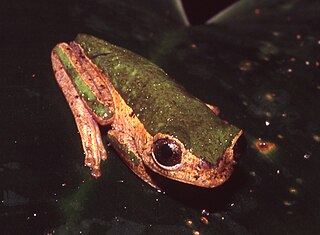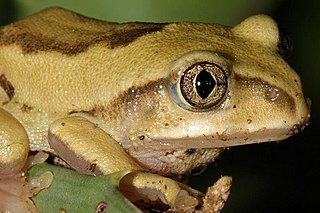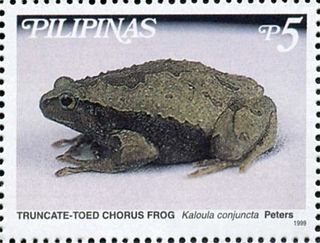
Dendropsophus minutus is a species of frog in the family Hylidae. It is found in Argentina, Bolivia, Brazil, Colombia, Ecuador, French Guiana, Guyana, Paraguay, Peru, Suriname, Trinidad and Tobago, Uruguay, and Venezuela. In Spanish it is known as ranita amarilla común.

Pithecopus palliatus is a species of frog in the subfamily Phyllomedusinae. It is found in Bolivia, Brazil, Ecuador, Peru, and possibly Colombia. Its natural habitats are subtropical or tropical moist lowland forests and intermittent freshwater marshes. It is threatened by habitat loss. It has been observed between 100 and 400 meters above sea level.

The brown banana frog, also known as the striped spiny reed frog, is an anuran in the family Hyperoliidae.

Heterixalus betsileo is a species of frogs in the family Hyperoliidae endemic to Madagascar. Its natural habitats are subtropical or tropical moist lowland forests, subtropical or tropical moist montane forests, moist savanna, subtropical or tropical seasonally wet or flooded lowland grassland, subtropical or tropical high-altitude grassland, swamps, freshwater marshes, intermittent freshwater marshes, arable land, rural gardens, urban areas, heavily degraded former forests, ponds, irrigated land, seasonally flooded agricultural land, and canals and ditches.
Hyperolius pyrrhodictyon is a species of frog in the family Hyperoliidae. It is endemic to Zambia. Its natural habitats are dry savanna, moist savanna, subtropical or tropical dry shrubland, subtropical or tropical moist shrubland, subtropical or tropical dry lowland grassland, subtropical or tropical seasonally wet or flooded lowland grassland, rivers, swamps, freshwater lakes, intermittent freshwater lakes, freshwater marshes, intermittent freshwater marshes, arable land, pastureland, urban areas, heavily degraded former forest, water storage areas, ponds, open excavations, irrigated land, seasonally flooded agricultural land, and canals and ditches.

The common reed frog is a species of tree frogs in the family Hyperoliidae found in Burundi, the Democratic Republic of the Congo, Ethiopia, Kenya, Rwanda, Sudan, Tanzania, and Uganda, and possibly the Central African Republic, Chad, and Eritrea. Its natural habitats are subtropical or tropical dry forest, subtropical or tropical moist lowland forest, subtropical or tropical moist montane forest, dry savanna, moist savanna, subtropical or tropical dry shrubland, subtropical or tropical moist shrubland, subtropical or tropical seasonally wet or flooded lowland grassland, subtropical or tropical high-altitude grassland, rivers, swamps, freshwater lakes, intermittent freshwater lakes, freshwater marshes, intermittent freshwater marshes, freshwater springs, arable land, pastureland, rural gardens, urban areas, heavily degraded former forests, water storage areas, ponds, irrigated land, seasonally flooded agricultural land, and canals and ditches.

Phlyctimantis maculatus is a species of frog in the family Hyperoliidae. They are silvery greyish-brown with dark brown to black spots, and derive their name from bright red coloring on the ventral side of their hind legs. Adult body length is typically 6 to 7.5 centimeters. These frogs have vertical pupils. Common names include red-legged running frog, brown-spotted tree frog, red-legged Kassina, red-legged pan frog, spotted running frog, tiger leg running frog, and vlei frog.

Leptopelis mossambicus, the brown-backed tree frog, Mozambique tree frog or Mossambique forest treefrog, is a species of frog in the family Arthroleptidae found in Eswatini, Malawi, Mozambique, South Africa, Zimbabwe, and possibly Botswana. Its natural habitats are dry savanna, moist savanna, subtropical or tropical moist shrubland, subtropical or tropical dry lowland grasslands, subtropical or tropical seasonally wet or flooded lowland grasslands, swamps, freshwater marshes, and intermittent freshwater marshes. It is threatened by habitat loss.

Leptodactylus fuscus is a species of frog in the family Leptodactylidae. Its local names are rã-assobiadora.

Leptodactylus melanonotus is a species of frog in the family Leptodactylidae. It is found in Central America.

The Philippine narrowmouth toad or the truncate-toed chorus frog is a species of frog in the family Microhylidae. It is endemic to the Philippines. Its natural habitats are subtropical or tropical dry forests, subtropical or tropical moist lowland forests, subtropical or tropical moist shrubland, subtropical or tropical seasonally wet or flooded lowland grassland, rivers, intermittent rivers, freshwater lakes, intermittent freshwater lakes, freshwater marshes, intermittent freshwater marshes, arable land, pastureland, plantations, rural gardens, heavily degraded former forest, water storage areas, ponds, irrigated land, and seasonally flooded agricultural land. It is threatened by habitat loss.

The banded rubber frog is a species of frog in the family Microhylidae. It is found in central and southern Africa. Its natural habitats are dry savanna, moist savanna, subtropical or tropical dry shrubland, subtropical or tropical moist shrubland, subtropical or tropical dry lowland grassland, subtropical or tropical seasonally wet or flooded lowland grassland, subtropical or tropical high-altitude grassland, intermittent freshwater lakes, intermittent freshwater marshes, arable land, pastureland, water storage areas, ponds, and canals and ditches. The female can reach a maximum size of 65 mm whereas the tadpoles can reach a size of 37 mm. The maximum size of the male is yet unknown, but sizes differ from 45 mm to 68 mm.

The Natal dwarf puddle frog is a species of frog in the family Phrynobatrachidae. It is found in Angola, Benin, Botswana, Burundi, Cameroon, Central African Republic, Republic of the Congo, Democratic Republic of the Congo, Ivory Coast, Eswatini, Eritrea, Ethiopia, Gambia, Ghana, Guinea, Guinea-Bissau, Kenya, Liberia, Malawi, Mali, Mozambique, Namibia, Nigeria, Rwanda, Senegal, Sierra Leone, South Africa, Sudan, Tanzania, Togo, Uganda, Zambia, Zimbabwe, and possibly Burkina Faso, Chad, Lesotho, and Mauritania.

The Angola river frog, or common river frog, is a species of frog in the family Pyxicephalidae. Formerly, it was placed in the family Ranidae.

The Woodworth's frog is a species of frog in the family Dicroglossidae. It is endemic to the Philippines. Its natural habitats are subtropical or tropical moist lowland forest, subtropical or tropical moist montane forest, subtropical or tropical moist shrubland, subtropical or tropical seasonally wet or flooded lowland grassland, rivers, intermittent rivers, freshwater lakes, intermittent freshwater lakes, freshwater marshes, intermittent freshwater marshes, freshwater springs, coastal freshwater lagoons, arable land, pastureland, plantations, rural gardens, urban areas, water storage areas, ponds, aquaculture ponds, open excavations, irrigated land, and seasonally flooded agricultural land.

The Mascarene grass frog, or Mascarene ridged frog, is a species of frog in the family Ptychadenidae. It is found in sub-Saharan Africa, Madagascar, and Mauritius.
Ptychadena stenocephala is a species of frog in the family Ptychadenidae. It is found in Cameroon, Côte d'Ivoire, Guinea, Uganda, possibly Central African Republic, possibly Liberia, and possibly Nigeria.
Zhangixalus dugritei is a species of frog in the family Rhacophoridae found in China and Vietnam, and possibly Laos and Myanmar. Its natural habitats are temperate forests, subtropical or tropical moist montane forests, subtropical or tropical seasonally wet or flooded lowland grassland, freshwater marshes, intermittent freshwater marshes, rural gardens, and heavily degraded former forests.

Polypedates leucomystax is a species in the shrub frog family Rhacophoridae. It is known under numerous common names, including common tree frog, four-lined tree frog, golden tree frog or striped tree frog. Many past authors have united it with the common Indian tree frog in P. maculatus, but today they are generally considered distinct species. In its native range, it is also called "white-lipped tree frog", but this name is otherwise applied to a species of true tree frogs.

Zhangixalus owstoni or Owston's green tree frog is a species of frog in the family Rhacophoridae which is endemic to Japan. Its natural habitats are subtropical or tropical moist lowland forests, subtropical or tropical seasonally wet or flooded lowland grassland, intermittent freshwater marshes, and irrigated land. It is threatened by habitat loss. The population is currently stable.



















